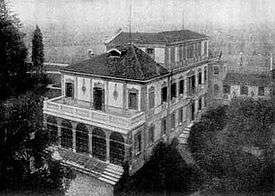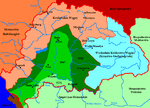Armistice of Villa Giusti
The Armistice of Villa Giusti ended warfare between Italy and Austria-Hungary on the Italian Front during World War I. The armistice was signed on 3 November 1918 in the Villa Giusti, outside of Padua in the Veneto, northern Italy, and took effect 24 hours later.
Background
By the end of October 1918 the Austro-Hungarian Army found itself in such a state that its commanders were forced to seek a ceasefire.
At the final stage of the Battle of Vittorio Veneto, the troops of Austria-Hungary were defeated, ceased to exist as a combat force and started a chaotic withdrawal. From 28 October onwards, Austria-Hungary sought to negotiate a truce but hesitated to sign the text of armistice. In the meantime the Italians reached Trento, Udine, and landed in Trieste. After the threat to break off the negotiations, on 3 November the Austro-Hungarians accepted the terms. The cease-fire would be started at 3.00 pm on 4 November, but due to a unilateral order of the Austro-Hungarian high command, the empire's forces stopped fighting on 3 November. After the war, the Kingdom of Italy annexed the Southern Tyrol (modern Trentino-Alto Adige/Südtirol), according to Treaty of London terms as well as Trieste and the Austrian Littoral.


Signatories
Italy:
- Tenente Generale Pietro Badoglio
- Maggior Generale Scipione Scipioni
- Colonnello Tullio Marchetti
- Colonnello Pietro Gazzera
- Colonnello Pietro Maravigna
- Colonnello Alberto Pariani
- Capitano di Vascello Francesco Accinni
Austria-Hungary:
- General Viktor Weber Edler von Webenau
- Oberst Karl Schneller
- Fregattenkapitaen Johannes Prinz von und zu Liechtenstein
- Oberstleutnant J.V. Nyékhegyi
- Korvettenkapitaen Georg Ritter von Zwierkowski
- Oberstleutnant i.G. Victor Freiherr von Seiller
- Hauptmann i.G. Camillo Ruggera
See also
- Bollettino della Vittoria address of General Diaz to his troops and the nation after the Armistice of Villa Giusti
